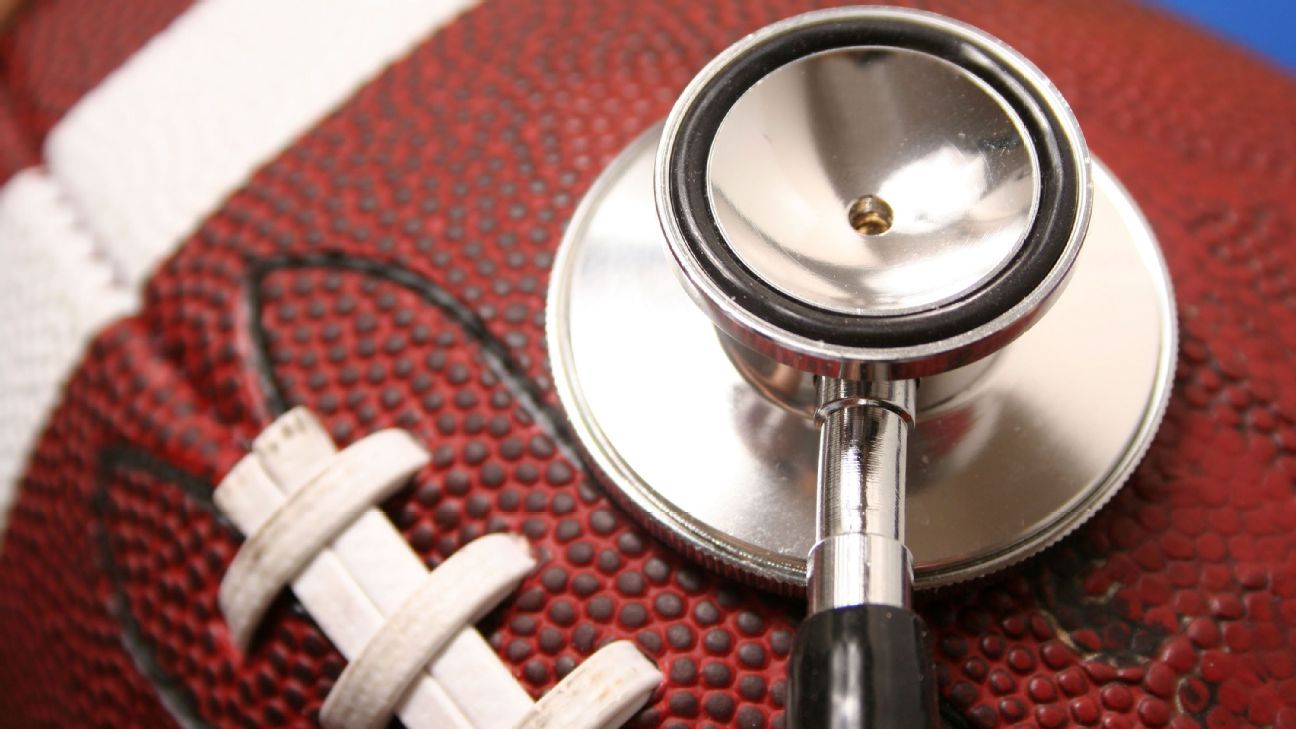A rare heart condition that could be linked with the coronavirus is fueling concern among Power 5 conference administrators about the viability of college sports this fall.
Myocarditis, inflammation of the heart muscle, has been found in at least five Big Ten Conference athletes and among several other athletes in other conferences, according to two sources with knowledge of athletes’ medical care.
The condition is usually caused by a viral infection, including those that cause the common cold, H1N1 influenza or mononucleosis. Left undiagnosed and untreated, it can cause heart damage and sudden cardiac arrest, which can be fatal. It is a rare condition, but the COVID-19 virus has been linked with myocarditis with a higher frequency than other viruses, based on limited studies and anecdotal evidence since the start of the pandemic.
The concern has “made the bar higher” for returning to fall sports, said Dr. Jonathan Drezner, director of the University of Washington Medicine Center for Sports Cardiology and a sports medicine physician who advises the NCAA on cardiac issues, “and it could be we don’t get there.”
Conference officials and athletic directors told ESPN that the uncertainty about the long-term effects of myocarditis has been discussed in meetings of presidents and chancellors, commissioners and athletics directors, and health advisory board members from the Big Ten, Pac-12 and other conferences around the country. Last week, college administrators saw a Facebook post from Debbie Rucker, mother of Indiana offensive lineman Brady Feeney, who wrote that her son was dealing with potential heart problems after battling COVID-19.
The Mid-American Conference, after receiving medical reports about myocarditis and other problems associated with the coronavirus, was the first FBS conference to postpone fall sports on Saturday.
“What we don’t know was really haunting us, and that’s why we came to our final decision,” Northern Illinois athletics director Sean Frazier said. “That’s part of the data that our presidents used. This mom gave us a play-by-play. That stuff is extremely scary.”
Dr. John MacKnight, the head primary care team physician at the University of Virginia, said that while questions about COVID-19 testing availability, turnaround time for results, and the impact of a possible community surge of cases have all been factors in deciding to return to competition, the long-term cardiac concerns for athletes may be the tipping point.
“We are collectively, as a sports nation, not quite ready to feel entirely comfortable with what that may look like for our young people down the line, and we are not going to put them in that situation,” he said. MacKnight, who directs care for Virginia’s athletes, and other school physicians are members of advisory groups that counsel universities and conferences on medical decisions.
MacKnight said “the likelihood the individual goes on to have myocardial complication is very low” in athletes who had no or very low-grade COVID-19 symptoms, but added that there needs to be more studies and data.
“There have been some concerns raised for that very reason: Do you not have uneasiness about having athletes participating knowing that you don’t know what that longer-range outlook is? The answer is of course, yes,” he said. “We don’t have enough information to say this is the likelihood that this will or will not happen.”
A spokesperson for the NCAA deferred questions about the number of athletes with myocarditis to individual colleges or conferences. NCAA chief medical officer Dr. Brian Hainline was not available for comment.
Dr. Matthew Martinez, director of sports cardiology for Atlantic Health System in New Jersey, said he has received calls from physicians from at least a dozen Power 5 schools who have identified more than a dozen athletes with some post-COVID-19 myocardial injury. He said about half of them had symptoms.
“Initially we thought if you didn’t have significant symptoms that you are probably at less risk. We are now finding that that may not be true,” he said.
Martinez, who is the league cardiologist for Major League Soccer, team cardiologist for the New York Jets and a consultant for the National Basketball Players Association, said based on what he’s seen so far among professional athletes who have had COVID-19, “I’m hopeful the number is under 5%” who have heart-related issues.
Even though the percentage is likely small, Martinez said there is still so much unknown that it is wise to take a conservative approach in returning athletes to play.
“We’re listening to doctors and scientists and continuing to prepare our schedule and prepare for the season,” Big 12 commissioner Bob Bowlsby told The Dallas Morning News on Sunday. “And yet the last two or three weeks have not been good to us. You’d be less than forthright if you didn’t acknowledge between the myocarditis and some of the other things that are new, it hasn’t raised the concern level. But nothing has been decided at this point.”
People can get myocardial inflammation, feel fine and never know it, Drezner said. He said most athletes who get myocarditis will be able to safely return to sports after a restriction of activity for three to six months. But he said that in some cases, the inflammation can turn to scar tissue and put the patient at risk for an irregular heartbeat that can lead to sudden cardiac arrest, which can be triggered by exercise.
A study published in July in JAMA Cardiology found that out of 100 adult patients in Germany who had recovered from the COVID-19 infection, 60% had findings of ongoing myocardial inflammation. A recent review of myocarditis listed with the National Center for Biotechnology Information cites some estimates that find 1% to 5% of all patients with acute viral infections may involve the myocardium, or the muscular tissue, of the heart.
“Myocarditis itself is certainly not new,” Drezner said, adding that prior studies have found that myocarditis represents up to 9% of sudden cardiac deaths among athletes.
But there have been no specific studies of COVID-related myocarditis on college-age adults or athletes. “I’ve heard about a handful of cases between some of the bigger schools,” he said, but said he was not aware of any cases specifically in the Pac-12. “Whether or not it’s 1% or 10%, it’s still important.”
Multiple colleges have started screening athletes for the condition, although their procedures vary, as does their confidence on whether those precautions will be enough to allow athletes to safely return to sports this fall.
Drezner said he and Dr. Aaron Baggish, director of the cardiovascular performance program at the Massachusetts General Hospital Heart Center and cardiologist for the New England Patriots, among other teams, plan to discuss how to start collecting COVID-19-related cardiac information on college athletes with Hainline, the NCAA chief medical officer, this week.
“We’ll be able to collect the results that we need to have a better understanding of what’s going on,” Drezner said.
A cardiac MRI provides the best definition of the heart in order to detect myocarditis and is the last step in a five-step component Drezner said he uses in assessing athletes at the University of Washington.
Drezner said post-COVID-19 cardiac evaluation for his Washington athletes includes: a review of any cardiovascular symptoms in athletes who have had COVID-19, an electrocardiogram — a measure of the heart’s electrical signals — to check for abnormalities, a blood test for troponin proteins that can signal heart inflammation, and a heart ultrasound to measure heart structure and function.
Depending on the results of those tests, he would conduct a short-term medical reevaluation. If needed, the last step would be the cardiac MRI.
Several athletic trainers and team physicians from within the Power 5 conferences told ESPN of different tactics they’re taking to address possible heart issues related to COVID-19 among athletes. Murphy Grant, a veteran athletic trainer and senior associate athletics director and athletics health care administrator at Wake Forest, said athletes who have had a confirmed positive COVID-19 test are being evaluated by a team physician 14 days after they recover, prior to returning to any sport-related activity, and that all athletes are receiving an electrocardiogram. If that detects any possible problems, the athlete would see a cardiac specialist, but that hasn’t yet been necessary, he said.
“We send a self-assessment every single day to [Wake Forest] student-athletes that they have to fill out electronically,” Grant said. “If something pops up — shortness of breath, chest pain, trouble breathing — our athletic trainers will know.”
MacKnight, the team physician at Virginia, said none of the athletes there have been diagnosed with myocarditis. He said he routinely consults with other physicians in the conference and said he was not aware of any athletes with COVID-related myocarditis in the ACC.
He said athletes at Virginia who have tested positive for COVID-19 are assessed for cardiac issues based on the severity of their COVID-19 symptoms, which he said might be a more conservative approach than what schools are doing elsewhere.
The German study found incidents of ongoing myocardial inflammation independent of preexisting conditions or the severity of COVID-19 in patients.
At Virginia, after being held out of participation up to three weeks, an athlete would get a repeat physical exam and electrocardiogram, and if those are normal for that athlete, the athlete would be slowly eased back into activity, MacKnight said. Any athlete who was hospitalized or had severe symptoms would receive additional tests and a referral to the cardiologist, he said.
“We had a fair number of positive [COVID-19] cases in the ACC … We’re talking about hundreds,” he said. “I’m aware of very few of them that would even fit into that higher illness severity category.”
West Virginia athletic director Shane Lyons, who is chair of the NCAA’s football oversight committee, recently made it mandatory at WVU that any athlete who tests positive for COVID-19 undergoes a series of tests, minimally an EKG, then an echocardiogram to determine if there are any abnormalities. If there are, Lyons said the athlete would then get a cardiac MRI — all of which can be done through a team of doctors at the WVU Heart and Vascular Institute.
“We understand it’s a concern of not understanding the impact the virus has on the heart, but is there not a possibility that we could require student-athletes who test positive — asymptomatic or symptomatic — that they go through heart workouts, such as EKG, echocardiogram, whatever their institution requires from a cardiac specialist?” Lyons said. “I don’t think it’s much different than a risk of an individual with sickle cell in that we mandate they go through a screening process as well. If this is a concern, and you have differing opinions of cardiologists, if they can detect whether it’s going to be safe to play or not, and we also need the American Heart Association to continue evaluating and weighing in on the issue.”
Dr. Kyle Goerl, team physician at Kansas State University who has worked with Drezner and others on providing advice to the NCAA, said at his school, all incoming athletes are tested for present COVID-19 infection by nasal swab and with a blood test for antibodies, which might indicate a prior infection.
Those who test positive receive an electrocardiogram and a blood test for troponin; the results of those tests and the degree of symptoms would help doctors determine whether to move forward with additional testing, he said. Even among the Power 5 schools, resources vary and factor into a program’s protocol, he said.
“Getting an echocardiogram in Seattle, Washington, is much different than getting one done in Manhattan, Kansas,” he said.
Goerl said none of the athletes at KSU have been found to have post-COVID heart issues so far, and he said he could not comment on whether there have been cases elsewhere in the Big 12.
Multiple attempts to reach members of the SEC’s medical advisory task force were unsuccessful or they declined to comment.
1:47
Heather Dinich explains why the Power 5 conferences are edging closer to postponing the college football season amid coronavirus concerns.
Heart issues linked to COVID-19 gained attention last week after the mother of Indiana offensive lineman Feeney posted her son’s plight on Facebook. She wrote: “Unfortunately this virus hit my son very hard compared to most of his teammates. Here was a kid in perfect health, great physical condition and due to the virus ended up going to the ER because of breathing issues. After 14 days of hell battling the horrible virus, his school did additional testing on all those that were positive. My son even received extra tests because he was one of the worst cases. Now we are dealing with possible heart issues! He is still experiencing additional symptoms and his blood work is indicating additional problems. Bottom line, even if your son’s schools do everything right to protect them, they CAN’T PROTECT THEM!!”
Feeney, an incoming freshman from St. Louis, was scheduled to visit a cardiologist last week. On Monday, in response to college football players around the country joining to Tweet #WeWantToPlay, Feeney wrote on Twitter: “Covid-19 is serious. I never thought I would have serious health complications from the virus, but look at what happened. … We need to listen to our medical experts.”
University of Houston defensive lineman Sedrick Williams announced on Facebook on Saturday that he was opting out of the 2020 season because of heart problems associated with COVID-19. Williams, a transfer from Kilgore College in Texas, tested positive in June and spent 14 days in quarantine.
“As a result of the virus, I’ve had complications with my heart and I really don’t know the outcome or what’s in store for me in the future,” Williams wrote. “I just know that my life is more precious to me than football could ever be. I’ve decided to opt out of the 2020 football season due to these complications. I won’t take this year for granted. I’m coming back bigger, faster and stronger than ever.”
The Boston Red Sox announced Aug. 1 that pitcher Eduardo Rodriguez was diagnosed with myocarditis and would miss the rest of the season. He had tested positive for COVID-19 before the start of summer camp and had been allowed to return to practice July 18. But a cardiac MRI a week later revealed his condition.
Drezner, the University of Washington physician, said the concern about myocarditis should “make all of us sort of press pause and do some due diligence so that we can feel the athlete is safe to exercise.
“We can’t rush into fall sports,” he said. “If we’re going to allow sports — where you can’t effectively physically distance — we have to ensure that the risk on the playing field is not necessarily higher than the risk they’re dealing with the rest of their college experience.
“If you can’t achieve that, you should not be putting your athletes at risk,” he said.
Dr. Peter Dean, a pediatric cardiologist at the University of Virginia who treats the college’s athletes along with MacKnight, was co-author of an analysis published last month by the American College of Cardiology about returning to play after a coronavirus infection. Although he hasn’t diagnosed myocarditis in any Virginia athletes who have had COVID-19 so far, he said he’s had athletes in the past with myocarditis caused by other factors.
“Most of the kids I have seen [who have myocarditis] had symptoms,” such as chest pains or palpitations, or they had passed out, he said. “After having them rest for three to six months, you repeat testing. If it’s all normal, they’re clear to go back to playing.”
The current screening for post-COVID-19 myocarditis among college athletes can detect the condition in those who haven’t had any symptoms, and the safest move is to hold them out, he said. But he said it’s helpful to keep in mind that the danger posed to athletes overall from COVID-19 is small.
“These are healthy kids who are generally not overweight … The risk of something awful is incredibly low,” he said. “I almost worry more about the coaching staff, the referees, and grandma and grandpa.”
ESPN college football reporter Heather Dinich and researcher John Mastroberardino contributed to this report.


